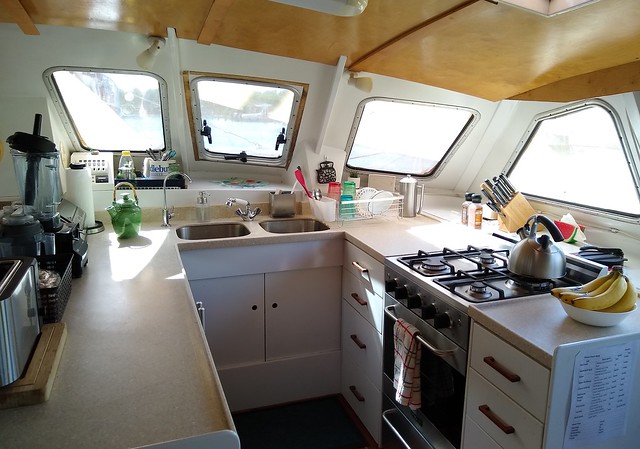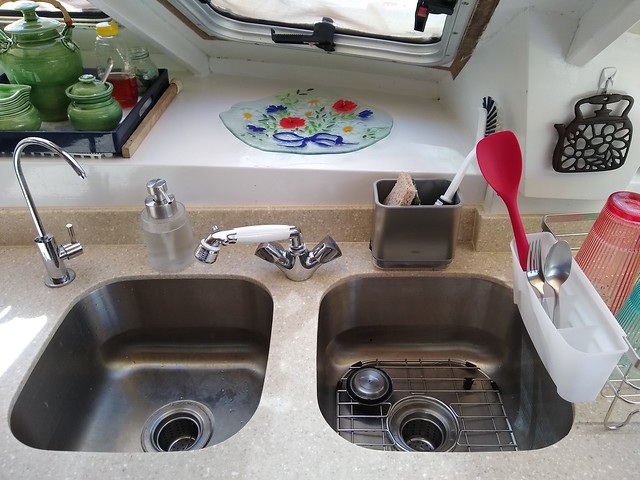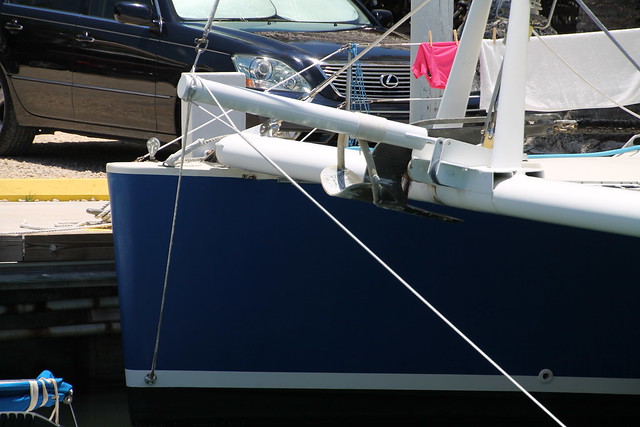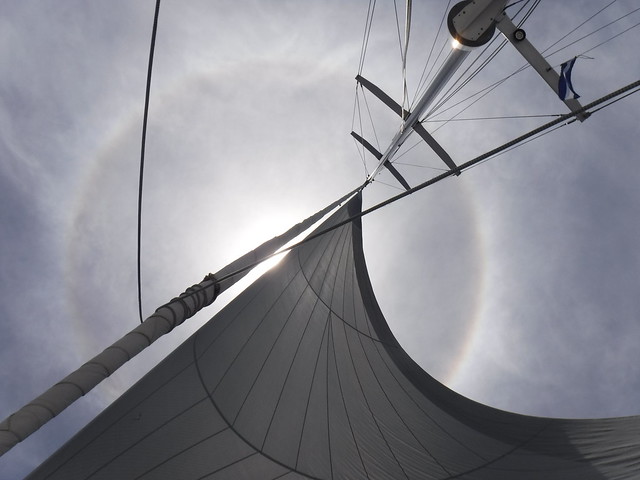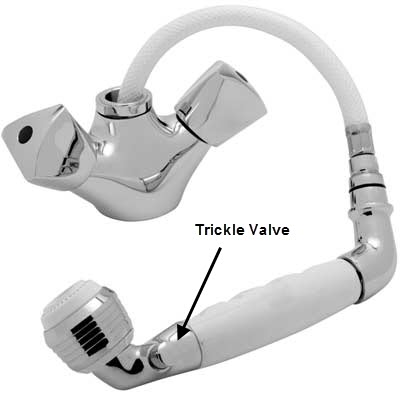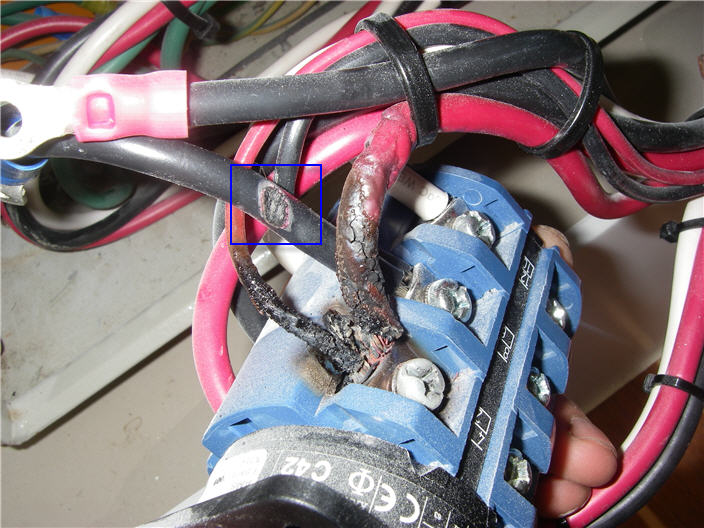I finally got a mechanic down to the boat last week. I’ve been meaning to do this since before Ibought the boat, but never got around to it.
I knew the news would be bad. Dothey ever give good news?
[more]
The port engine is very hard to start. It has to be cranked for 60-120 seconds (notcontinuously) before it will fire. Whenit does, it only runs on one cylinder and understandably very rough. After it has warmed up for a few minutes, theother cylinders will start to fire, after which it is fine and will run allday.
A diesel engine is pretty simple. It doesn’t have spark plugs, but insteadrelies on the air in the cylinder being heated by compression and a fine sprayof fuel being injected into the cylinder at the right time to cause combustion. Simple, but precise. The piston has to fit perfectly in thecylinder to create the compression, and the fuel has to be sprayed at theperfect time, in the perfect pattern, and under very high pressure.
I have managed to put together a few pieces of the boat’sstory. The engines were commissioned inNovember 2000 by a mechanic in Sarasota.
This was interesting because I didn’t know the boat had ever been inthis area. I have a logbook that starts ayear later in November 2001, in Fort Lauderdale, when the engines have 145hours on them. The logbook containsseveral entries that indicate that the port engine had problems even then. It mentions some “blow by” and that theengine was accidentally run with the raw water intake closed, causing it tooverheat.
The overheating back then could very likely be root cause ofmy problems today. When metal gets hotit gets soft and expands. Getting softcan lead to deformation, and expansion within the small tolerances of acylinder can lead to increased friction and wear (which leads to more heat andmore friction until your engine seizes).
Overheating is not conducive for maintaining compression inside theengine.
The “blow by” he notes is a compression problem, but isrelated to the rings at the top of the cylinder not fitting correctly andallowing gas to escape. It is usually arelatively easy fix and not a long-term problem.
Generally, the first thing a mechanic wants to know when heencounters a diesel that won’t fire is if there is compression. This can be done by removing the glow plugs (littleelectrodes that pre-heat the air in the cylinder for easier starting), fittinga pressure gauge, and cranking it. It ishard to say what pressure is good and what is bad, but the cylinders should allbe about the same. It is definitely bad whenyou have one cylinder that is 50% higher than the others, and that cylinderworks when the others don’t. Alas, thisis the case.
It is a pretty safe bet that what is going on inside theengine is that the engine has to be turned over (either by the starter, or by the“good” cylinder) until the pistons heat up from enough friction to expand and thepressure rises enough to allow combustion.
While the engine is turning over, the injectors are dumping fuel intothe cylinders, which washes away the lubricating oil. This increases the friction and helps thecylinders to heat up and thus fire earlier, but it also causes wear and thestarting problem will get worse and worse until someday the engine just won’tstart.
What is the solution?
Well, the piston has to be made to fit perfectly in the cylinder. The cylinder therefore has to be bored larger(probably half a millimeter) and fitted with larger pistons, or the cylinderhas to be sleeved and re-bored to the original spec and the pistons replaced. Of course this can’t be done in the boat so theengine has be removed and re-installed, adding about two days of labor. Ballpark estimate: $4,000.
Now, this isn’t all that terrible in boat-money terms. Where it gets complicated is when youconsider that after spending the four grand, I’ll still have a pair of tiredold 30 horsepower engines that really probably should have been 40s or 50s tobegin with. The real question here is doI want to take this boat long-distance with these engines? Ballpark estimate for two new 40HP engines andmatched propellers: $40,000.
The mechanic that did this compression test for me was thesame guy who commissioned the engines in 2000.
I did that on purpose. He helpedme collect some of the pieces of the history puzzle. Also, he wrote in his 2000 report that theboat motored at 9 knots. Now, I’ve spentsome time on this boat and the only time I’ve seen 9 knots is with a nicebreeze and a big sail. The best I’veseen under power is about 5.5. I wantedto meet the man who said this boat went 9 knots on these engines. He verified that it did indeed happen andnoted that the engines did not achieve anywhere near their rated RPMs.
As I’ve alluded to before, there are many factors toconsider when trying to maximize boat speed and minimize fuel consumption. The boat’s shape and weight areconstants. The engine manufacturerconsiders the RPM a constant. The gearratio is a constant. There areenvironmental considerations such as temperature, wind, and sea state, but themain variable is the propeller. Whatdiameter, how many blades, what blade pitch?
Apparently, it is possible to pitch the propellers such that the boatcan go 9 knots, but the engines can’t turn them at the speed the manufacturersays is ideal. How bad this is, I don’tknow. I also note that however the propswere pitched then, and however they are now, the engines do run faster, butstill don’t get what the manufacturer considers “cruising speed”.
The boat has fancy feathering propellers that orientthemselves to the water when sailing to reduce drag. They have adjustable pitch, but unfortunatelythe boat has to be pulled out to make the adjustment. Pulling this boat out is not something you docasually. I know that the propellerswere removed and sent off to be serviced by the manufacturer sometime after thecommissioning. Whether the pitch was thesame when the propellers were returned I don’t know, but this seems the mostlikely point at which the pitch would have been changed, perhaps inadvertently.
All stuff to consider.
In the meantime we plan to run the port engine as-is. We found that all the glow plugs were dead(probably from a tricky control panel switch that keeps them on unnecessarily)so those are being replaced. They reallyaren’t necessary in this climate, but anything that can raise the temperaturein the cylinders is a good thing. Sincewe already had the injectors out, we figured it wouldn’t hurt either to havethem cleaned on the chance that a bad spray pattern was inhibiting combustion. When that is all done and the engine is backtogether I’ll have to find another mechanic to come take it all apart again andgive me a second opinion before I consider going any further.
Update 11/03/08
After reassembling the engine with the new glow plugs and the rebuilt injectors it starts amazingly well. Like immediately. It still runs unevenly when it is cold, and it seems to not warm up as quickly, probably due to the water getting colder, but at least I don't have to crank it nearly as much. The mechanic's bill was $1,500 and while I'm not pleased with some of his billing practices, I think it was money well spent. The starboard engine has now begun starting sluggishly and probably needs the same treatment. I'll be doing that one myself.



